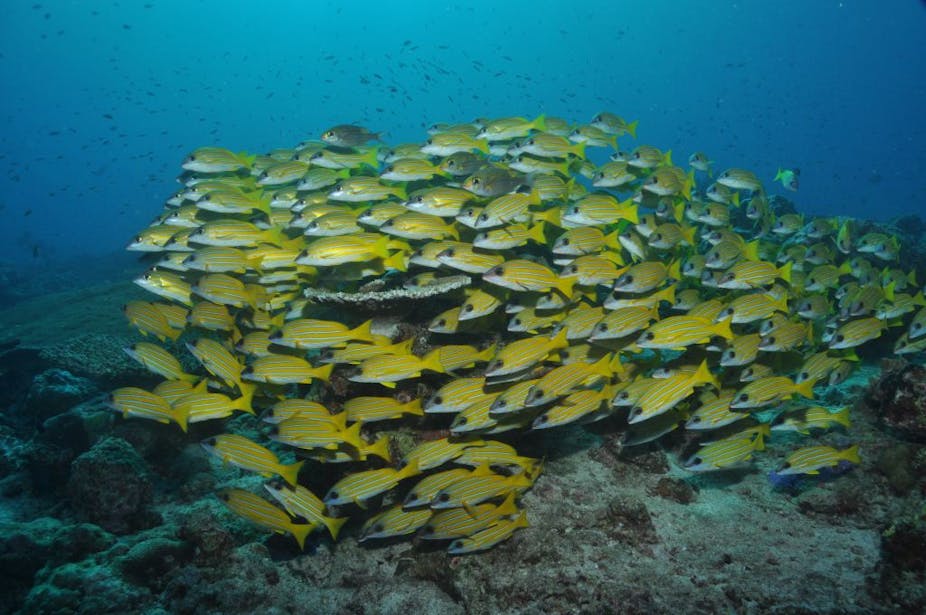I first heard used the term “biodiversity” as a graduate student some years ago. While it appeared to be something everyone agreed was important, nobody could tell me exactly what it meant. It seemed to mean something different depending on who was using the word. For example, Wikipedia proposes the delightfully vague definition: “Biodiversity is the degree of variation of life forms within a given species, ecosystem, biome, or planet.”
Since the days of Darwin and Linnaeus, the number of different species in an ecosystem — what researchers call “species richness” — has dominated the scientific view of global biodiversity patterns. It has long been used as a biological basis for managing vulnerable ecosystems. But merely counting the number of species in a particular place has its limitations.
Picture two rockpools on the seashore. Put five species of fish in each one, but one pool has five individuals of each species, whereas the other contains only one individual of four species and 21 of the fifth. Both pools have the same species richness and same abundance of fish, but with an uneven distribution, with the second pool being dominated by a single species.
This is a well known problem, and various measures have been developed since the 1940’s to describe how the abundance of species is not by nature evenly distributed. But when we try and apply these over large areas for the purposes of environmental management, we run into difficulties because of the need for directly comparable estimates of species abundance. Usually researchers are forced to use various meta-analytical techniques, incorporating scattered, sometimes incompatible sources of data from studies with varying methodologies.
In an effort to overcome the this approach’s potential to introduce bias, researchers at the University of Tasmania have established the Reef Life Survey. This ongoing survey of the world’s coastal reefs uses a combination of professional researchers and trained volunteer divers to collect data of fish and invertebrate abundance using a single, consistent methodology. The project has so far completed over 6,000 surveys at more than 2,000 sites in 40 countries.
So, we now have consistently-collected abundance data across a wide range of latitudes, habitats and climates with which to examine biodiversity patterns at the largest scales.
But just counting species and their abundance patterns is still a very crude way of understanding diversity. Instead, we gathered information on their traits - what they eat, how they move, where they live. This way we can understand more about how they vary in terms of their function, their ecological niche in the natural working of their ecosystems. It is this, functional variation of species that is the real essence of biodiversity.
Returning to our rockpools: imagine that one pool contains a fish, a crab, and a kelp plant. The other contains three species of fish. Which is more diverse? Intuitively, we know it’s the one with the fish, crab, and kelp, although both have the same number of species.
In a new global analysis of reef fishes recently published in Nature, we have noted how the members of each species make a living by creating a detailed matrix of “functional traits.” These include what they eat (plankton, invertebrates, algae, other fish, or a combination), how they eat it (browsing, scraping, or predation), where they live (in, on, or near the bottom, attached, or free-swimming), how gregarious they are (solitary, paired, or schooling), and whether they are active at night or during the day.
By replacing the identity of or abundance of species with their range of ecological traits, and incorporating how frequently these traits appear, this challenges our perception of where the most biodiverse regions of the globe are. Coral reefs generally possess more fish species than at higher latitudes, but a trait-based view reveals new hotspots of biodiversity in places like south-west Africa and southern Australia - locations well outside the species-rich tropical regions.
At scales relevant to resource management, many species do more or less the same or similar things – fulfilling similar functional roles in the ecosystem with only small or subtle differences between them. The loss of a particular species may not imperil the function of the system as a whole. But where only a small proportion of the species share similar traits, we have much higher functional diversity - and ecosystems that are potentially much more vulnerable.
We should perhaps be having a harder look at how well higher latitude marine ecosystems – like around the UK – are being represented by no-take marine protected areas. These not only give us the opportunity to see what relatively natural marine ecosystems should look like, but help to protect and reinstate functionally diverse assemblages of species that are susceptible to human influence.

